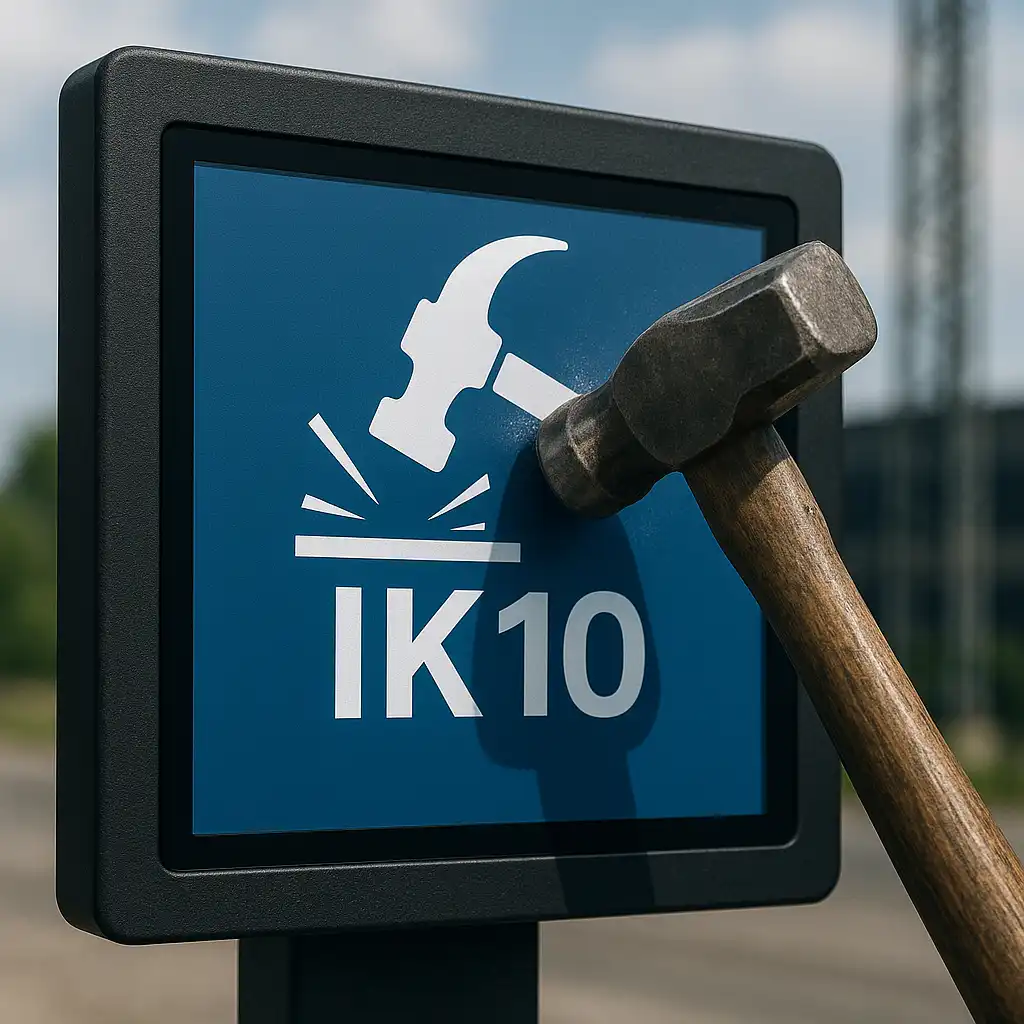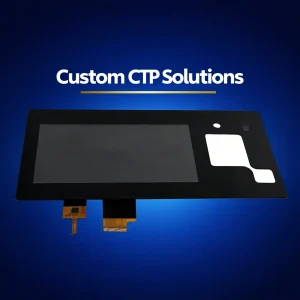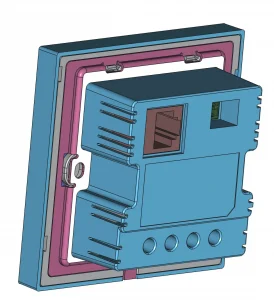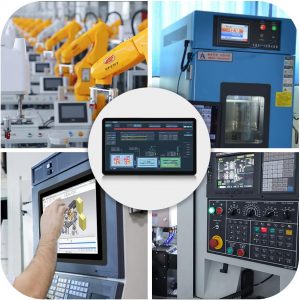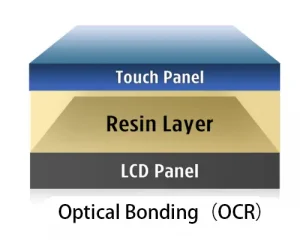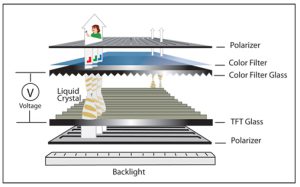When designing rugged and reliable industrial displays, two of the most important impact protection standards to consider are IK10 display and IK09 display ratings. These ratings, defined by the IEC 62262 standard, indicate how well a display can resist mechanical impacts in harsh environments. An IK10 display offers the highest protection level, withstanding impacts up to 20 joules, making it ideal for vandal-proof and outdoor HMI applications. An IK09 display provides slightly lower—but still robust—protection at 10 joules, suitable for EV chargers, public kiosks, and semi-outdoor terminals. This article explains how IK ratings work, the relationship between cover glass thickness and impact resistance, and how to design a custom IK10-rated display for your industrial application.
What Is IK Rating and Why Does It Matter in Industrial Displays
Understanding the IK Rating System
The IK rating is defined by the international standard IEC 62262. It classifies the degree of protection provided by enclosures for electrical equipment against external mechanical impacts.
| IK Code | Impact Energy | Equivalent Drop | Typical Use Case |
|---|---|---|---|
| IK06 | 1 joule | 500g object from 20cm | Indoor equipment |
| IK07 | 2 joules | 500g object from 40cm | Light factory automation |
| IK08 | 5 joules | 1.7kg object from 29.5cm | Outdoor kiosks, vending machines |
| IK09 | 10 joules | 5kg object from 20cm | EV chargers, public terminals |
| IK10 | 20 joules | 5kg object from 40cm | Vandal-proof devices, outdoor HMIs |
A higher IK rating means better protection from physical impact. For example, an IK10 display can withstand a 5kg hammer hitting the screen from a height of 40 cm without damage.
Why IK Rating Is Critical for Industrial Displays
In environments such as factories, construction sites, and public access areas, industrial displays are often exposed to accidental drops, bumps, or even vandalism. Choosing a high IK rating ensures durability, minimizes downtime, and improves device lifespan.
Cover Glass Thickness vs IK Rating: What’s the Real Relationship?
One of the most direct ways to improve a display’s IK rating is by increasing the thickness of the cover glass. Below is a reference table correlating typical glass thicknesses with IK protection levels:
| Cover Glass Thickness | Typical IK Rating |
| 2.0mm | IK06 |
| 3.0mm | IK07 |
| 4.0mm | IK08 |
| 5.0mm | IK09 |
| 6.0mm | IK10 |
Note: These values are approximations. Actual IK rating results can vary depending on glass material, bonding method, and housing design.
Thicker glass distributes impact energy more effectively, reducing the chance of screen breakage. However, this is just one part of the equation.
Impact of IK Ratings on Cover Glass Thickness and Touch Sensitivity
Achieving a higher IK rating typically requires thicker or more reinforced cover glass to withstand greater impact energy. While increasing cover glass thickness enhances the durability and protection of an impact-resistant display, it also introduces challenges for capacitive touch screen performance. Thicker glass reduces capacitive touch sensitivity because the electrical signals from the user’s finger must penetrate a thicker dielectric layer.
To maintain optimal touch responsiveness in a custom touch screen paired with thicker, impact-resistant glass, careful selection of the touch controller IC and precise firmware tuning are essential. Advanced touch ICs utilize stronger driving signals and sophisticated noise filtering algorithms to compensate for the signal attenuation caused by thicker glass. Therefore, designing an IK10 display with touch functionality involves a delicate balance between mechanical robustness and touch responsiveness, often requiring customized IC solutions and extensive calibration.
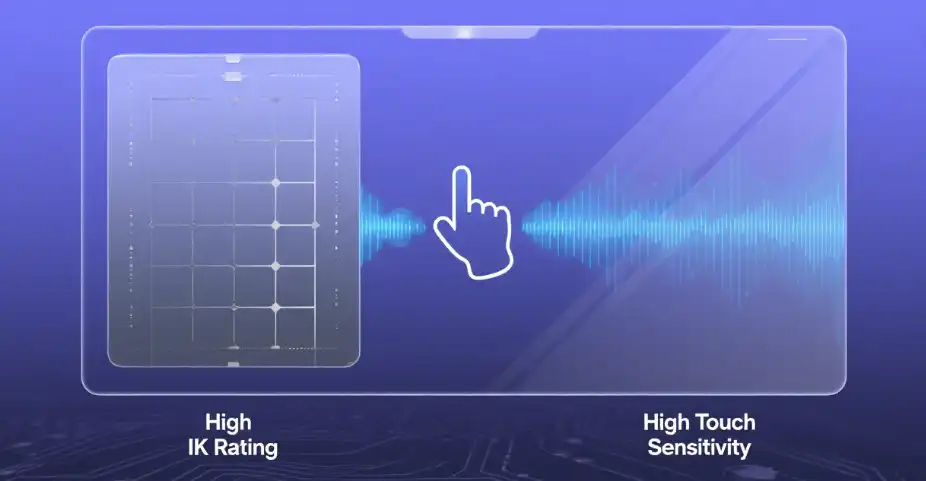
Other Factors That Influence the IK Rating of Custom Touch Screens
Glass Material Selection
Tempered glass is commonly used due to its strength and shatter-resistant properties. Alternatives like chemically strengthened glass or polycarbonate may also be used in specific applications. Polycarbonate offers excellent impact resistance but is prone to scratching.
Optical Bonding vs Air Bonding
Optical bonding fills the gap between the cover glass and display, significantly increasing rigidity and durability. Air bonding, by contrast, leaves an air gap that can act as a weak point during impact.
Mounting and Structural Support
Even with thick, bonded glass, a poorly designed housing can compromise impact resistance. Mechanical support along the edges and back panel reinforcement are critical for achieving IK10 compliance.
Touch Technology and Display Size
Glass+Glass (G+G) touch structures are more robust than G+F or G+F+F configurations. Additionally, larger displays are more vulnerable at the center and require stronger structural support to achieve the same IK level.
Common Impact-Resistant Displays and Their Application Scenarios
Each IK level corresponds to specific use environments and protection needs. Here’s a breakdown:
- IK06–IK07: Typically used in indoor industrial equipment or light factory automation settings where only minor mechanical impact is expected.
- IK08: Suitable for semi-public and outdoor environments like kiosks, smart vending machines, and industrial touch monitors that may face accidental knocks.
- IK09–IK10: Required for public terminals, EV charging stations, outdoor HMIs, and any location where vandalism or deliberate damage is a concern.
Choosing the right IK rating depends not only on the risk of physical damage but also on the maintenance and safety standards of the operating environment.

When Is an IK10 Display Necessary?
IK10-rated displays are not always required—but in environments where equipment is exposed to public access, frequent physical interaction, or the risk of vandalism, IK10 becomes essential. You should consider an IK10 display if:
-
The device is installed in unattended or high-traffic areas
-
There is a risk of intentional damage or heavy accidental impact
-
The screen needs to withstand hits from tools, objects, or vandalism
-
Maintenance access is limited, and long-term durability is a priority
-
The display must meet strict safety or certification standards
By evaluating these factors, you can determine whether the extra protection of an IK10-rated screen is justified for your specific use case.
Custom Impact-Resistant Display Solutions from Rocktech
We specialize in designing and manufacturing custom touch screen solutions tailored to meet specific IK requirements.
Our services include:
- Custom cover lens thickness and materials
- Optical bonding with OCA/LOCA
- Touch panel integration (capacitive/resistive)
- Structural design support
- Certification testing and consultation
Our industrial displays come with extended temperature support, water resistance, sunlight-readable screens, and anti-glare coatings, delivering versatile performance for a wide range of indoor and outdoor industrial applications.
Conclusion: Designing a True Impact-Resistant IK10 Display
Achieving IK10 protection goes far beyond simply using thicker glass. It requires a holistic design approach—incorporating proper materials, bonding techniques, mounting structures, and housing support. When all these elements come together, you get a truly rugged, reliable, and long-lasting custom touch screen.
If you’re developing industrial displays that need to withstand serious impact, contact us to discuss your impact-resistant display requirements. We’re here to help you create robust, dependable solutions for your industrial applications.

